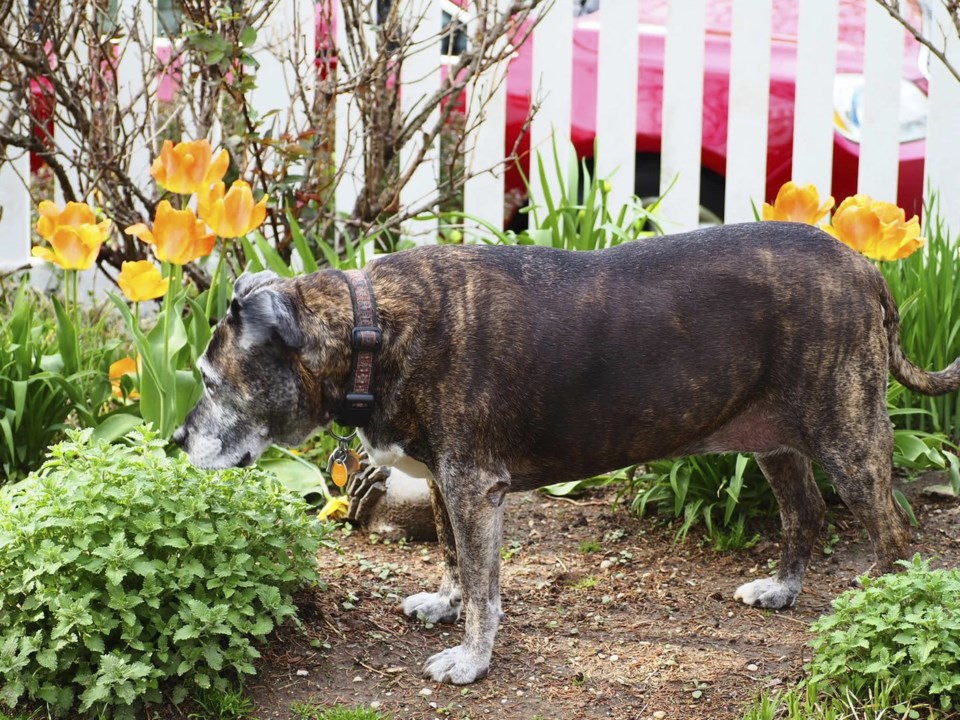If you’ve ever had a dog, you know they don’t exactly tiptoe through the tulips. I’m fortunate that none of mine ever had a penchant for digging holes, but my late pit bull, Maddie, used to run through my perennial beds like a weed whacker, leaving horizontal coneflowers and black-eyes Susans in her destructive path.
Her bathroom breaks would also imprint an ever-expanding array of canine crop circles on the lawn.
Fortunately, my little Havanese, Miguel, doesn’t pose as much of a threat to my plants, but there are other important elements to consider when planning a garden where dogs and plants can safely coexist.
Let’s start with the lawn
The type of grass you select should be suited to your region and your sun exposure. In my sunny Northeastern front yard, that means starting with a Kentucky bluegrass seed blend, which holds up well against foot and paw traffic, and mixing in roughly 10 percent each of urine-resilient perennial ryegrass and shade-tolerant fine fescue.
For further protection, consider incorporating a trample- and urine-resistant groundcover into your grass-seed recipe. I’ve added clover, which also enriches the soil with safe, nourishing levels of nitrogen (free fertilizer!) and reduces or eliminates groundwater pollution from my property.
If you have a beagle-size dog or two, this will go a long way toward retaining your lawn’s integrity. But, to be honest, I don’t know of any grass that will hold up against a German shepherd or bull mastiff kicking it up on a daily basis. Still, starting with the most resilient grass species for your growing conditions will give you the best odds possible.
Barriers to entry
Typical landscaping designs often space plants far apart, leaving areas of mulch-covered soil between plants and shrubs. Dogs love to run obstacle courses on those bare paths, kicking up mulch and, invariably, straying into planting beds.
Instead, opt for a dense garden style that allows only enough space between plants for the expected mature size of each. By their third year, most of the gaps will be filled, eliminating the spaces and, along with them, the invitation to enter.
If you grow delicate plants or edibles, situate them in a raised bed or surround them with short fencing or another barrier to discourage entry.
Avoid toxic plants and chemicals
Next, consider safety. Many common plants are toxic to dogs (and cats), so avoid planting them altogether, even if your pet hasn’t shown an interest in grazing. A one-time curiosity could spell disaster. Check with the ASPCA for a sortable list of plants (including weeds) that are toxic to cats, dogs and horses, and remove any that your pets could access.
Avoid using chemicals. If you must apply them, keep pets out of the garden until the products have dried or dissipated (read package labels carefully and observe warnings and cautionary statements).
Create a zone for digging and playing
If your dog is a digger, fill holes and lay sections of chicken wire over favorite digging spots, then cover them with a few inches of soil. I’ve never met a dog that wasn’t deterred by wire.
Diggers will continue to dig, however, so designate a section of the yard where they can do so with reckless abandon. Bury some toys and bones for them to find, and place balls and other toys in there too. After introducing dogs to the area, watch closely and bring them to the digging zone whenever you catch them in the act elsewhere.
Such a play area or dog run would be a beneficial garden addition even if digging hasn’t posed a problem, as it would reduce or eliminate plant trampling and lawn damage. Enclose it with fencing or another barrier that allows you to keep an eye on the dog -- and vice versa.
Similarly, if space allows, designate a pebbled or mulched potty area. Train dogs to use it by moving scooped poop to the spot. Their noses will convey the message, but again, you’ll have to watch closely and move them to the spot when they show signs of intent to relieve themselves elsewhere. It will take some time, but they should catch on.
Finally, be sure to provide access to a clean bowl of water at all times. It will refresh pups as they play outdoors and, as a bonus, dilute their urine to cut down on burn spots in your grass.
Yes, you’ll likely have to lower your aesthetic standards a bit. But getting to relish two of life’s greatest pleasures simultaneously is well worth the compromise.
___
Jessica Damiano writes weekly gardening columns for the AP and publishes the award-winning Weekly Dirt Newsletter. You can sign up here for weekly gardening tips and advice.
___
For more AP gardening stories, go to https://apnews.com/hub/gardening.
Jessica Damiano, The Associated Press




